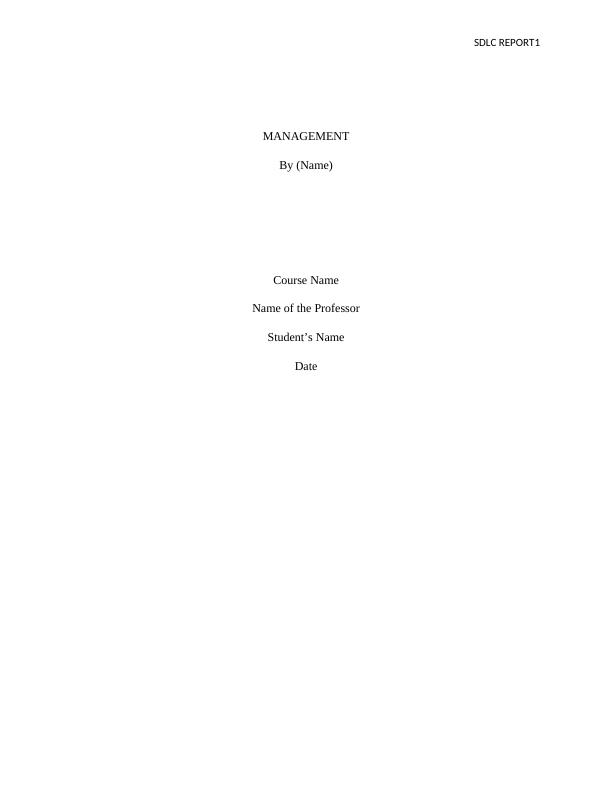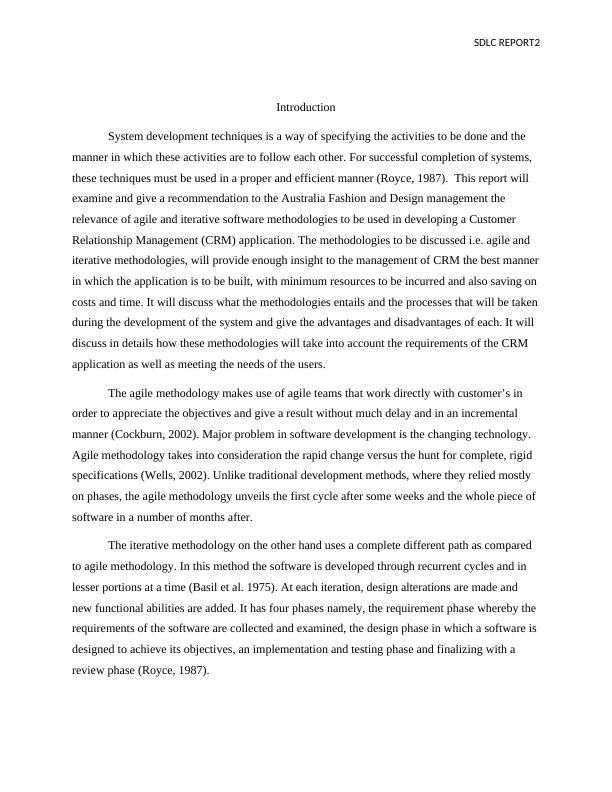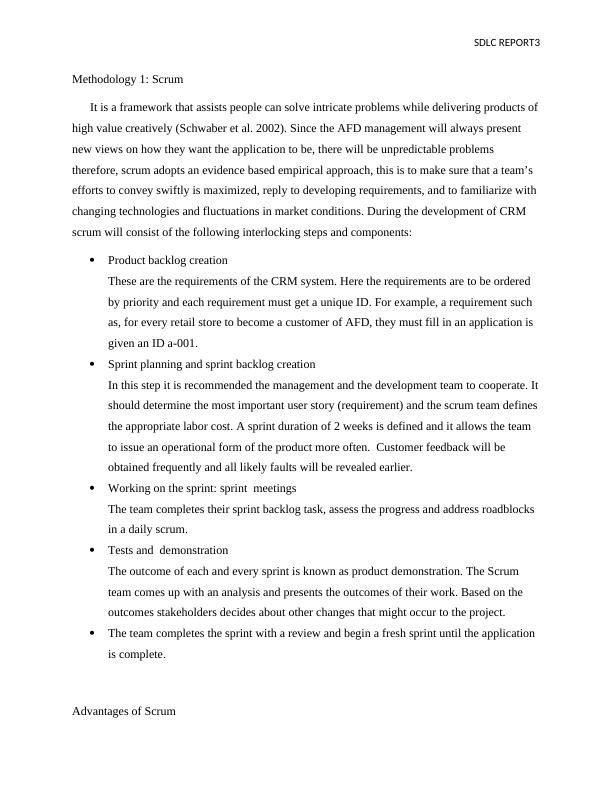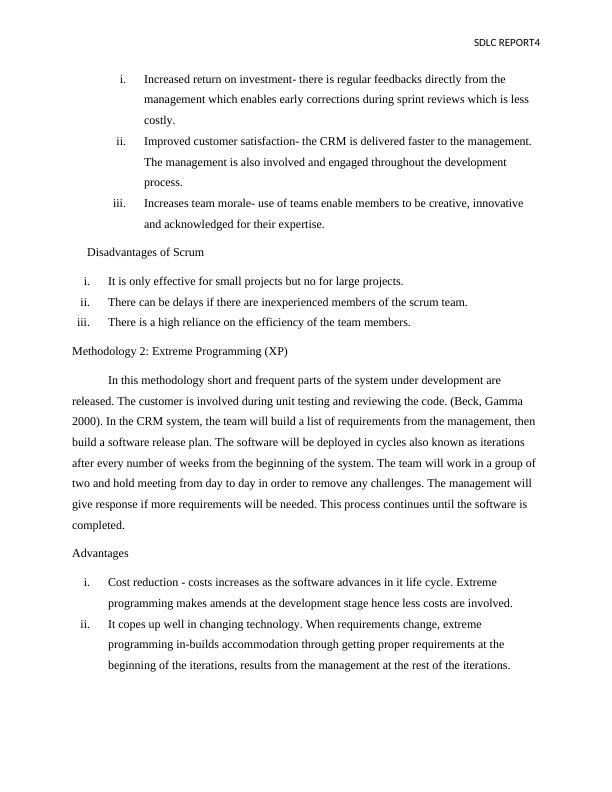Agile and Iterative Software Methodologies for Developing a Customer Relationship Management Application
Added on 2023-06-11
13 Pages2966 Words70 Views
SDLC REPORT1
MANAGEMENT
By (Name)
Course Name
Name of the Professor
Student’s Name
Date
MANAGEMENT
By (Name)
Course Name
Name of the Professor
Student’s Name
Date

SDLC REPORT2
Introduction
System development techniques is a way of specifying the activities to be done and the
manner in which these activities are to follow each other. For successful completion of systems,
these techniques must be used in a proper and efficient manner (Royce, 1987). This report will
examine and give a recommendation to the Australia Fashion and Design management the
relevance of agile and iterative software methodologies to be used in developing a Customer
Relationship Management (CRM) application. The methodologies to be discussed i.e. agile and
iterative methodologies, will provide enough insight to the management of CRM the best manner
in which the application is to be built, with minimum resources to be incurred and also saving on
costs and time. It will discuss what the methodologies entails and the processes that will be taken
during the development of the system and give the advantages and disadvantages of each. It will
discuss in details how these methodologies will take into account the requirements of the CRM
application as well as meeting the needs of the users.
The agile methodology makes use of agile teams that work directly with customer’s in
order to appreciate the objectives and give a result without much delay and in an incremental
manner (Cockburn, 2002). Major problem in software development is the changing technology.
Agile methodology takes into consideration the rapid change versus the hunt for complete, rigid
specifications (Wells, 2002). Unlike traditional development methods, where they relied mostly
on phases, the agile methodology unveils the first cycle after some weeks and the whole piece of
software in a number of months after.
The iterative methodology on the other hand uses a complete different path as compared
to agile methodology. In this method the software is developed through recurrent cycles and in
lesser portions at a time (Basil et al. 1975). At each iteration, design alterations are made and
new functional abilities are added. It has four phases namely, the requirement phase whereby the
requirements of the software are collected and examined, the design phase in which a software is
designed to achieve its objectives, an implementation and testing phase and finalizing with a
review phase (Royce, 1987).
Introduction
System development techniques is a way of specifying the activities to be done and the
manner in which these activities are to follow each other. For successful completion of systems,
these techniques must be used in a proper and efficient manner (Royce, 1987). This report will
examine and give a recommendation to the Australia Fashion and Design management the
relevance of agile and iterative software methodologies to be used in developing a Customer
Relationship Management (CRM) application. The methodologies to be discussed i.e. agile and
iterative methodologies, will provide enough insight to the management of CRM the best manner
in which the application is to be built, with minimum resources to be incurred and also saving on
costs and time. It will discuss what the methodologies entails and the processes that will be taken
during the development of the system and give the advantages and disadvantages of each. It will
discuss in details how these methodologies will take into account the requirements of the CRM
application as well as meeting the needs of the users.
The agile methodology makes use of agile teams that work directly with customer’s in
order to appreciate the objectives and give a result without much delay and in an incremental
manner (Cockburn, 2002). Major problem in software development is the changing technology.
Agile methodology takes into consideration the rapid change versus the hunt for complete, rigid
specifications (Wells, 2002). Unlike traditional development methods, where they relied mostly
on phases, the agile methodology unveils the first cycle after some weeks and the whole piece of
software in a number of months after.
The iterative methodology on the other hand uses a complete different path as compared
to agile methodology. In this method the software is developed through recurrent cycles and in
lesser portions at a time (Basil et al. 1975). At each iteration, design alterations are made and
new functional abilities are added. It has four phases namely, the requirement phase whereby the
requirements of the software are collected and examined, the design phase in which a software is
designed to achieve its objectives, an implementation and testing phase and finalizing with a
review phase (Royce, 1987).

SDLC REPORT3
Methodology 1: Scrum
It is a framework that assists people can solve intricate problems while delivering products of
high value creatively (Schwaber et al. 2002). Since the AFD management will always present
new views on how they want the application to be, there will be unpredictable problems
therefore, scrum adopts an evidence based empirical approach, this is to make sure that a team’s
efforts to convey swiftly is maximized, reply to developing requirements, and to familiarize with
changing technologies and fluctuations in market conditions. During the development of CRM
scrum will consist of the following interlocking steps and components:
Product backlog creation
These are the requirements of the CRM system. Here the requirements are to be ordered
by priority and each requirement must get a unique ID. For example, a requirement such
as, for every retail store to become a customer of AFD, they must fill in an application is
given an ID a-001.
Sprint planning and sprint backlog creation
In this step it is recommended the management and the development team to cooperate. It
should determine the most important user story (requirement) and the scrum team defines
the appropriate labor cost. A sprint duration of 2 weeks is defined and it allows the team
to issue an operational form of the product more often. Customer feedback will be
obtained frequently and all likely faults will be revealed earlier.
Working on the sprint: sprint meetings
The team completes their sprint backlog task, assess the progress and address roadblocks
in a daily scrum.
Tests and demonstration
The outcome of each and every sprint is known as product demonstration. The Scrum
team comes up with an analysis and presents the outcomes of their work. Based on the
outcomes stakeholders decides about other changes that might occur to the project.
The team completes the sprint with a review and begin a fresh sprint until the application
is complete.
Advantages of Scrum
Methodology 1: Scrum
It is a framework that assists people can solve intricate problems while delivering products of
high value creatively (Schwaber et al. 2002). Since the AFD management will always present
new views on how they want the application to be, there will be unpredictable problems
therefore, scrum adopts an evidence based empirical approach, this is to make sure that a team’s
efforts to convey swiftly is maximized, reply to developing requirements, and to familiarize with
changing technologies and fluctuations in market conditions. During the development of CRM
scrum will consist of the following interlocking steps and components:
Product backlog creation
These are the requirements of the CRM system. Here the requirements are to be ordered
by priority and each requirement must get a unique ID. For example, a requirement such
as, for every retail store to become a customer of AFD, they must fill in an application is
given an ID a-001.
Sprint planning and sprint backlog creation
In this step it is recommended the management and the development team to cooperate. It
should determine the most important user story (requirement) and the scrum team defines
the appropriate labor cost. A sprint duration of 2 weeks is defined and it allows the team
to issue an operational form of the product more often. Customer feedback will be
obtained frequently and all likely faults will be revealed earlier.
Working on the sprint: sprint meetings
The team completes their sprint backlog task, assess the progress and address roadblocks
in a daily scrum.
Tests and demonstration
The outcome of each and every sprint is known as product demonstration. The Scrum
team comes up with an analysis and presents the outcomes of their work. Based on the
outcomes stakeholders decides about other changes that might occur to the project.
The team completes the sprint with a review and begin a fresh sprint until the application
is complete.
Advantages of Scrum

SDLC REPORT4
i. Increased return on investment- there is regular feedbacks directly from the
management which enables early corrections during sprint reviews which is less
costly.
ii. Improved customer satisfaction- the CRM is delivered faster to the management.
The management is also involved and engaged throughout the development
process.
iii. Increases team morale- use of teams enable members to be creative, innovative
and acknowledged for their expertise.
Disadvantages of Scrum
i. It is only effective for small projects but no for large projects.
ii. There can be delays if there are inexperienced members of the scrum team.
iii. There is a high reliance on the efficiency of the team members.
Methodology 2: Extreme Programming (XP)
In this methodology short and frequent parts of the system under development are
released. The customer is involved during unit testing and reviewing the code. (Beck, Gamma
2000). In the CRM system, the team will build a list of requirements from the management, then
build a software release plan. The software will be deployed in cycles also known as iterations
after every number of weeks from the beginning of the system. The team will work in a group of
two and hold meeting from day to day in order to remove any challenges. The management will
give response if more requirements will be needed. This process continues until the software is
completed.
Advantages
i. Cost reduction - costs increases as the software advances in it life cycle. Extreme
programming makes amends at the development stage hence less costs are involved.
ii. It copes up well in changing technology. When requirements change, extreme
programming in-builds accommodation through getting proper requirements at the
beginning of the iterations, results from the management at the rest of the iterations.
i. Increased return on investment- there is regular feedbacks directly from the
management which enables early corrections during sprint reviews which is less
costly.
ii. Improved customer satisfaction- the CRM is delivered faster to the management.
The management is also involved and engaged throughout the development
process.
iii. Increases team morale- use of teams enable members to be creative, innovative
and acknowledged for their expertise.
Disadvantages of Scrum
i. It is only effective for small projects but no for large projects.
ii. There can be delays if there are inexperienced members of the scrum team.
iii. There is a high reliance on the efficiency of the team members.
Methodology 2: Extreme Programming (XP)
In this methodology short and frequent parts of the system under development are
released. The customer is involved during unit testing and reviewing the code. (Beck, Gamma
2000). In the CRM system, the team will build a list of requirements from the management, then
build a software release plan. The software will be deployed in cycles also known as iterations
after every number of weeks from the beginning of the system. The team will work in a group of
two and hold meeting from day to day in order to remove any challenges. The management will
give response if more requirements will be needed. This process continues until the software is
completed.
Advantages
i. Cost reduction - costs increases as the software advances in it life cycle. Extreme
programming makes amends at the development stage hence less costs are involved.
ii. It copes up well in changing technology. When requirements change, extreme
programming in-builds accommodation through getting proper requirements at the
beginning of the iterations, results from the management at the rest of the iterations.

End of preview
Want to access all the pages? Upload your documents or become a member.
Related Documents
Information System Designlg...
|4
|742
|463
System Analysis and Designlg...
|13
|1658
|447
System Analysis: OZES Case Studylg...
|19
|2873
|68
IMAT5205 Systems Analysis And Designlg...
|10
|2166
|43
Propose appropriate PM application systems for successful project execution in infrastructure and resource industrieslg...
|2
|564
|39
System Analysis and Designlg...
|15
|2115
|73
